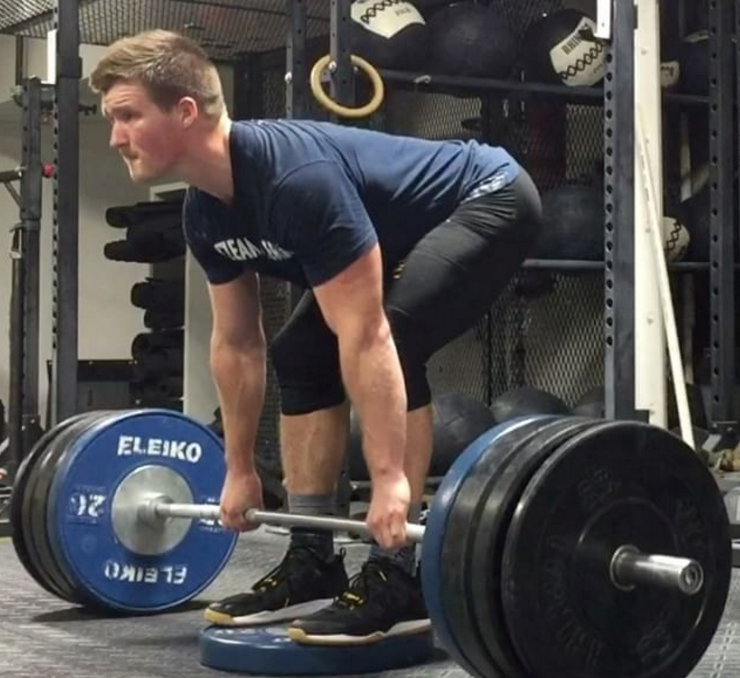Romanian Deadlift Alternatives for Muscle Growth and Strength | BarBend (original) (raw)
In an earlier article we discussed the immense benefits the Romanian deadlift can offer weightlifters, powerlifters, functional fitness athletes, and general trainees alike. Whether the purpose is to increase hamstring and glute development, enhance back and positional strength specific to olympic weightlifting, or further develop an athlete’s pulling mechanics; the Romanian deadlift is by far one of the top exercises of choice for most coaches and athletes.
**_[If you are a weightlifter or fitness athlete, you must read these_** 3 tips to snatch more weight!]
At times, however, athletes and coaches may find it difficult to include such an amazing exercise into a program for whatever reason. Often, this is due to poor hinging mechanics, lack of control of a lifter, or flexibility limitations. Nonetheless, coaches and athletes must adapt to find alternative exercises that are suitable for individual situations while simultaneously re-patterning and teaching the main lift (in this case the Romanian deadlift) until a lifter can grasp this foundational movement.

In this article we will discuss a few alternative exercises that can be done to elicit similar benefits to the Romanian deadlift. It is important to note, none of these replace the need for athletes to be able to perform the full Romanian deadlift movement, as it is not only a foundational movement pattern for nearly every main lift in powerlifting, weightlifting, and functional fitness, it by far has some of the best abilities to add quality strength and muscle mass to the glutes, hamstrings, and back.
Romanian Deadlift Benefits
Here is a brief overview of the benefits coaches and athletes can expect from Romanian deadlifts.
- Develop hamstring and lower back strength
- Pattern positional strength specific to cleans and snatches
- Enhance posterior activation and patterning that directly correlates with deadlifting and low bar squats
- Increase muscular hypertrophy of the hamstrings, lower back, glutes, and upper back to have directly application to most athletic movements (training, jumping, running, etc)
Muscles Worked
Below is a listing of the primary muscles targeted by the Romanian deadlift (in no specific order).
- Hamstrings
- Gluteus Maximus
- Spinal Erectors (lower back muscles)
- Trapezius and Middle Back
Romanian Deadlift Alternative #1: Do Romanian Deadlifts Correctly
No, I’m not just trying to be a smart a$#. Romanian deadlifts are one of, if not THE best exercise to target the hamstrings, lower back, and glutes. By skipping out on this exercise you truly are limiting your progress (it’s kinda like skipping squats on leg day…kinda). Many lifters will complain of lower back pain afterwards, which often suggests that they are doing these wrong. Before loading weight, think about using your hamstrings, and moving under control.
[Back pain has a ton of causes, but sometimes soft tissue work can help — check out our pick for the best foam roller for back pain.]
Too often I see beginners and even “seasoned” lifters performing these with rounded backs, too heavy of loads, and neglecting their spinal columns. For most people, using 25-50% of your non-rounded conventional deadlift will be more than enough to elicit some serious hypertrophy and strength. Without mastering this movement, your lower back will never get the help it deserves from the hamstrings, glutes, and positional awareness that it deserves during deadlifts, cleans, snatches, and squats.
**_[Do deadlifts hurt you lower back? Odds are your are doing them wrong! Read_** here to start fixing your form!]
Romanian Deadlift Alternative #2: Good Mornings
This is a good alternative to target nearly identical muscle groups as the Romanian deadlift. Additionally, this back loaded movement places greater emphasis on upper and lower back strength as the lifter must fix the barbell on their back and maintain rigidity. I often find this is a good supplemental lift, and/or training regression for some lifters who have issues maintaining a rigid, flat back during Romanian deadlifts (however do not have hamstring and hip mobility issues). Generally speaking, this movement is done with lighter loads (20-40% of back squat for moderate reps to build movement integrity and hypertrophy).
Alternative #3: Back Extensions/Glute Hamstring Developers (GHDs)
Both of these movements involve hip flexion and extension while a lifter must assume a rigid spine. These movements can be performed with bent knees to isolate the hamstrings and glutes, or with straighter knees to place more emphasis on the lower and middle back.
When loading weight, I often suggest lifters and athletes place their hands behind their heads or a barbell in the same position they have it when they back squat, as this forces the lifters to stay active throughout the spinal muscles and resist the urge to forward flex/round the spine. I find both of these movements do well in the moderate to higher rep ranges, for controlled, even paused repetitions (static holds at top of movement) when looking to develop strength and muscular hypertrophy.
Final Words
The Romanian deadlift is one of the most popular and effective movements, regardless of sport, to bring about increases in hamstring, glute, and lower back strength and hypertrophy. In addition, the sport specificity and positional patterning that it offers makes it a crucial movement to master for every athlete. While the above three movements can help to bridge the gaps, they are by no means complete replacements of the Romanian deadlift, and therefore coaches and athletes should master all movements in this article to truly maximize performance (especially the Romanian deadlift).
Featured Image: J2FIT on Youtube